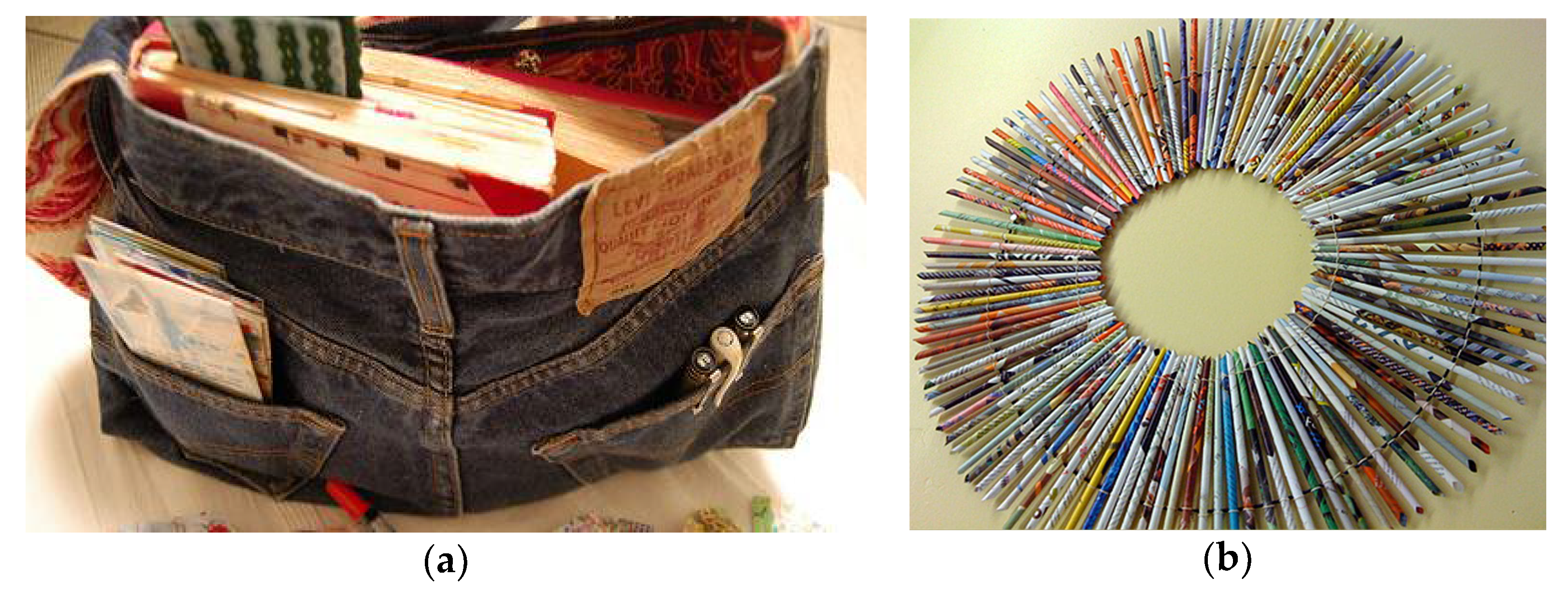From Trash to Treasure: Unlocking the Power of Resource Conservation, Recycling, and Waste Management Practices
1. Introduction
2. Resource conservation, Recycling and Waste Management
2.1. Resource conservation
2.2. Recycling
2.3. Waste Management
3. Call-to-Action
4. Conclusions
Author Contributions
Funding
Acknowledgments
Conflicts of Interest
References
- Gleason, C. Wood Pallet Projects: Cool and Easy-to-Make Projects for the Home and Garden; Fox Chapel Publishing: Mount Joy, PA, USA, 2013. [Google Scholar]
- IHanna. Handbag Made Out of Old Jeans. 2008. Available online: https://www.ihanna.nu/blog/2008/01/handbag-from-old-jeans/ (accessed on 10 August 2023).
- Pamphlets in the Daily Newspaper into Decorative Placemat. Dollar Store Crafts. Available online: https://dollarstorecrafts.com/ (accessed on 10 August 2023).
- Muneneh, M. An Exploration Into Barriers To Use Of Waste Glass in Interior Spaces in Nairobi. Doctoral Dissertation, University of Nairobi, Nairobi, Kenya, 2013. [Google Scholar]
- V-Surf Limited. Available online: https://vsurf.co/ (accessed on 10 August 2023).
- Yuan, X.; Kumar, N.M.; Brigljević, B.; Li, S.; Deng, S.; Byun, M.; Lee, B.; Lin, C.S.K.; Tsang, D.C.W.; Lee, K.B.; et al. Sustainability-inspired upcycling of waste polyethylene terephthalate plastic into porous carbon for CO2 capture. Green Chem. 2022, 24, 1494–1504. [Google Scholar] [CrossRef]
- Kumar, N.M.; Chopra, S.S. Blockchain-assisted spent electric vehicle battery participation for load frequency control problems in interconnected power systems is resilient, low-carbon, and offers revenues to the operators. Sustain. Energy Technol. Assessments 2023, 57, 103209. [Google Scholar] [CrossRef]
- Nallapaneni, M.K. Electric vehicle revolution among Hong Kong residents: Ways to handle the inevitable surge in battery waste in line with circular economy principles. In Proceedings of the Research Assistant Professors Selection Panel Committee Meeting, Department of Building Environment and Energy Engineering, The Hong Kong Polytechnic University (PolyU), Hong Kong, China, 21 April 2023. [Google Scholar] [CrossRef]
- Foo, D. Process Integration for Resource Conservation; CRC Press: Boca Raton, FL, USA, 2016. [Google Scholar]
- Kumar, N.M.; Chopra, S.S. Insights into material recovery, revenue, and global warming potential of India’s end-of-life photovoltaic installations reveals the urgent need for blockchain-based solar passports. Sustain. Energy Technol. Assess. 2023, 58, 103326. [Google Scholar]
- Carlson, A.E. Recycling norms. Calif. L. Rev. 2001, 89, 1231. [Google Scholar] [CrossRef]
- Hamer, G. Solid waste treatment and disposal: Effects on public health and environmental safety. Biotechnol. Adv. 2003, 22, 71–79. [Google Scholar] [CrossRef] [PubMed]
Disclaimer/Publisher’s Note: The statements, opinions and data contained in all publications are solely those of the individual author(s) and contributor(s) and not of MDPI and/or the editor(s). MDPI and/or the editor(s) disclaim responsibility for any injury to people or property resulting from any ideas, methods, instructions or products referred to in the content. |
© 2023 by the authors. Licensee MDPI, Basel, Switzerland. This article is an open access article distributed under the terms and conditions of the Creative Commons Attribution (CC BY) license (https://creativecommons.org/licenses/by/4.0/).
Share and Cite
Nallapaneni, M.K.; Hait, S.; Priya, A.; Bohra, V. From Trash to Treasure: Unlocking the Power of Resource Conservation, Recycling, and Waste Management Practices. Sustainability 2023, 15, 13863. https://doi.org/10.3390/su151813863
Nallapaneni MK, Hait S, Priya A, Bohra V. From Trash to Treasure: Unlocking the Power of Resource Conservation, Recycling, and Waste Management Practices. Sustainability. 2023; 15(18):13863. https://doi.org/10.3390/su151813863
Chicago/Turabian StyleNallapaneni, Manoj Kumar, Subrata Hait, Anshu Priya, and Varsha Bohra. 2023. "From Trash to Treasure: Unlocking the Power of Resource Conservation, Recycling, and Waste Management Practices" Sustainability 15, no. 18: 13863. https://doi.org/10.3390/su151813863
APA StyleNallapaneni, M. K., Hait, S., Priya, A., & Bohra, V. (2023). From Trash to Treasure: Unlocking the Power of Resource Conservation, Recycling, and Waste Management Practices. Sustainability, 15(18), 13863. https://doi.org/10.3390/su151813863






